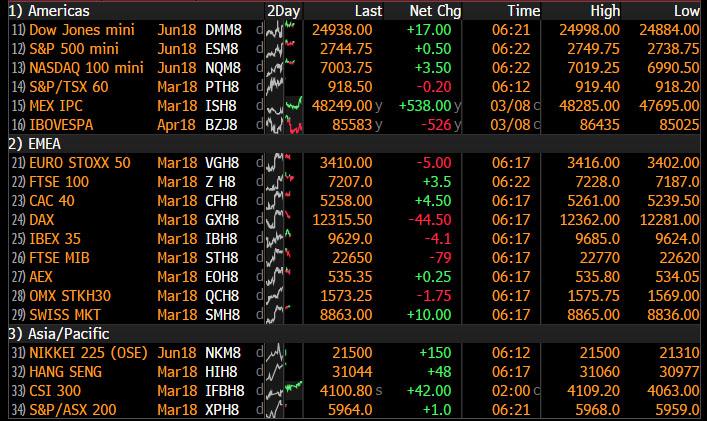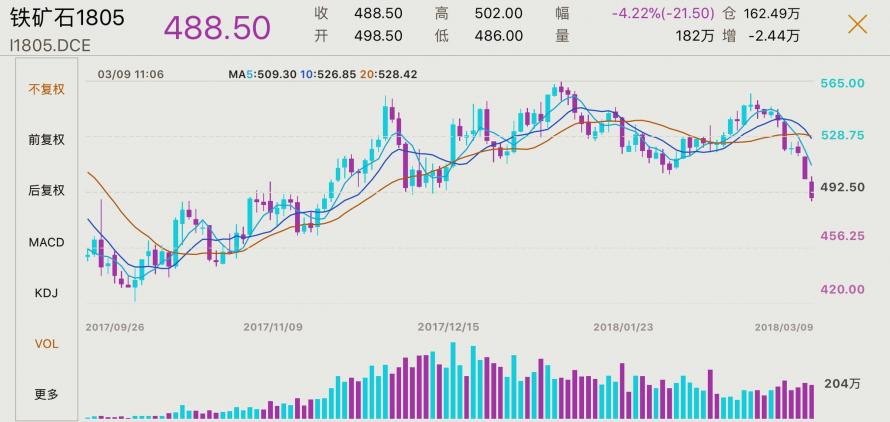After a barrage of breaking, surprise headlines and geopolitical developments, markets fall back to the familiar rhythm of trading the monthly payrolls (+205K exp), or rather, the far more important average hourly earnings (+2.8% Y/Y exp.) report. This morning, global shares hit a one-week high before easing a touch, as caution ahead of jobs data, and a potential disappointment in wage inflation outweighed a potential breakthrough in nuclear tensions over the Korean peninsula.
As a result, futures are somewhat mixed, with Asia trading higher, while Europe started off on the back foot but has recovered losses. The MSCI All-Country World index was 0.1% higher and set for a weekly gain of almost 2%.

As is traditionally the case ahead of payrolls, S&P futures have hugged the flatline.

Gains came mostly from Asian stocks which staged sharp rallies after U.S. President Donald Trump said he was prepared to meet North Korea’s Kim Jong Un, potentially marking a major breakthrough in nuclear tensions between the two countries. The summit news overshadowed a warning from China that it will take “strong” measures to counter U.S. trade tariffs.
“While it is easy to be cynical, one can’t help feeling these talks could well go the same way as previous attempts. But nonetheless it will be interesting to see how this one plays out,” said Michael Hewson, chief markets analyst at CMC Markets.
Commenting on Trump’s two main announcement this week, one desk had the following interestinh commentary:
President Trump must be delighted that his policies are paying off. His bellicose tweets have brought North Korea to the negotiating table and his use of cold war steel tariffs is effectively an invitation for trading partners to make him their best offer in order to secured tariff exemption. A weaker dollar is clearly part of Trump’s protectionist agenda as well and we believe investors will be looking to sell into any near-term dollar rallies.
As previewed, the market now will focus onto today’s employment report in the US. The consensus is for a 205k February payrolls number, which follows 200k in January. The unemployment rate is expected to dip to 4.0% from 4.1%. But it’s the average hourly earnings print which is the bigger component focus for the market right now given the obsession with inflation. The market forecasts a +0.2% mom print (which should lower than annual rate by one-tenth to +2.8% yoy, driven by base effects).
Going into payrolls, Asian stocks were higher across the board after the lead from US where Trump confirmed aluminium and steel tariffs, but exempted NAFTA partners and was also said to be open to providing relief for allies. In addition, Asia-Pac risk appetite was further bolstered by geopolitical developments in which the South Korean National Security Office chief announced that North Korean Leader Kim is committed to denuclearization and will refrain from conducting further tests, with President Trump and North Korea’s Kim to meet by May.
Overnight, in its latest announcement, the BoJ kept monetary policy unchanged as expected with NIRP held at -0.1% and 10yr JGB yield target at around 0%. The decision was made by 8-1 vote with board member Kataoka the sold dissenter, who called for the BoJ to buy JGBs so 10yr yields or longer drop further and repeated that the BoJ should clarify it will ease further if domestic factors delay reaching price target. At the post-meeting press conference, Governor Kuroda faced a barrage of questions about the so-called exit from the current monetary easing scheme, but according to Goldman, the governor damped expectations for the exit for the foreseeable future. In fact, Goldman adds, and we agree, that it will be difficult for the BOJ to normalize interest rates before the impact of the next consumption tax hike, slated for October 2019, has run its course, given the weakness of upward pricing pressures and the strong intentions of the government.
Australia’s ASX 200 (+0.3%) and Nikkei 225 (+0.5%) were positive but with upside capped by a subdued commodities sector and weakness across steel names on Trump tariffs, while KOSPI (+1.0%) outperformed on the further appeasement in the Korean peninsula. Not helping the growth narrative was China’s CPI which came in blistering hot, surging 2.9%, or the most in 5 years. Elsewhere, Hang Seng (+1.1%) was underpinned amid the broad positivity in the region, while the Shanghai Composite (+0.6%) somewhat lagged after PBoC inaction led to a net weekly drain of CNY 240bln.
Also overnight, outgoing PBOC Governor Zhou Xiaochuan said market-access reforms should be accelerated and that the world’s second-largest economy “can be bolder in opening up”; Deputy Governor Yi Gang said stable progress will be made on capital-account convertibility.
Other key Chinese data:
Chinese commodities were hit hard by the jump in inflation and trade war announcement, with iron ore plunging 5%, now down 14% from February peak; steel rebar futures -7.8% this week in Shanghai, on course for biggest slump in a year.

European equities erased earlier losses before edging higher, chasing gains in the U.S. and Asia as the U.S. non-farm payrolls report draws near. Automakers remain underperformers as trade-related concerns linger. The Stoxx Europe 600 Index was fractionally higher (+0.1%) and heading for a weekly advance of 2.6%. GVC Holdings is one of the best performers on the gauge after the company said it made a strong start to 2018. Lagardere drags media shares to the worst industry group performance after posting weaker-than-expected full-year results.German Jan. ind. production fell 0.1% m/m; est. +0.6% m/m. U.K. February retail sales drop as BDO sees more ‘casualties.’
In global macro, the overnight narrative was dominated by the yen and the Norwegian krone, with the USDJPY jumping after Trump agreed to meet Kim Jong Un in an unprecedented summit; meanwhile, Norway’s headline inflation print beat every single estimate and came in higher than the central bank’s newly reduced target, providing fodder to krone bulls. The EUR/USD dropped below 1.2300, while MXN and CAD among the strongest major currencies after Mexico and Canada’s tariff exemption. Asia’s emerging currencies were mixed as concern over U.S. metals tariffs and possible retaliation from other nations was offset by news of the first ever meeting between the leaders of the U.S. and North Korea.













Leave A Comment